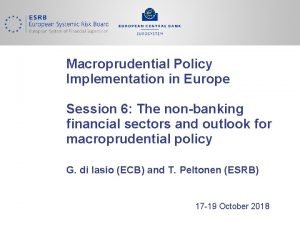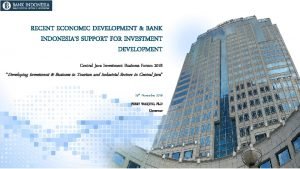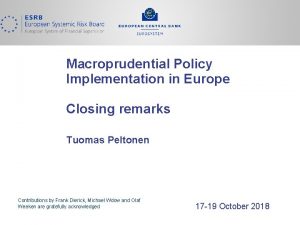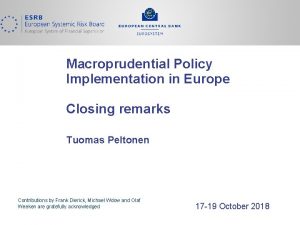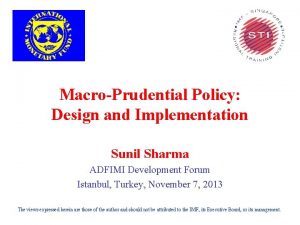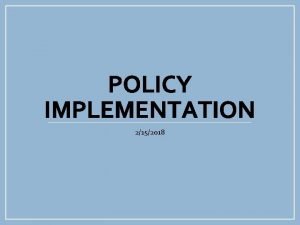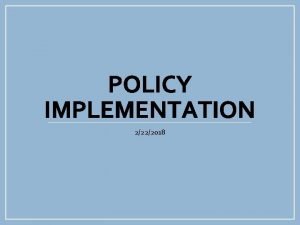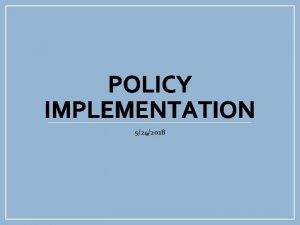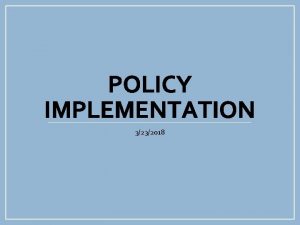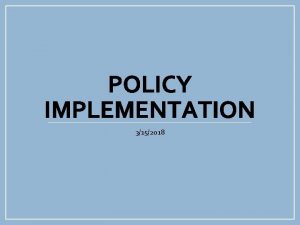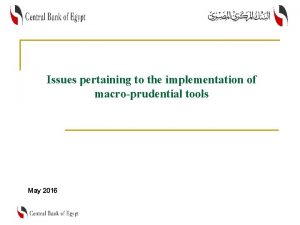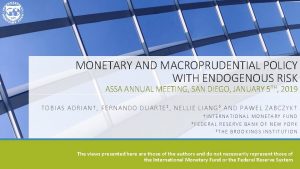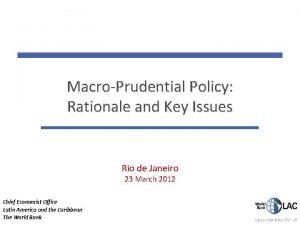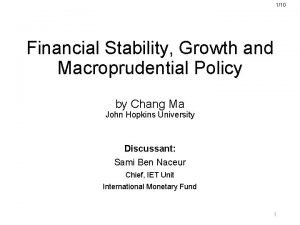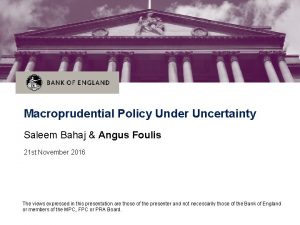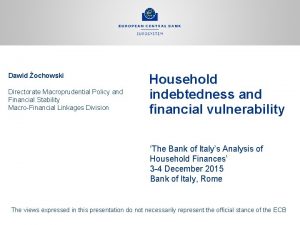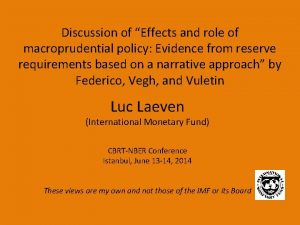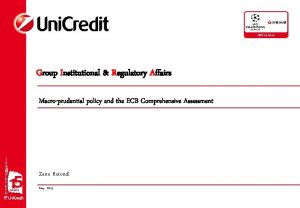Macroprudential Policy Implementation in Europe Session 6 The












































- Slides: 44

Macroprudential Policy Implementation in Europe Session 6: The non-banking financial sectors and outlook for macroprudential policy G. di Iasio (ECB) and T. Peltonen (ESRB) 17 -19 October 2018

Overview 1. Introduction 2. Risk Monitoring 3. Macroprudential policy initiatives / instrument development 4. Outlook for macroprudential policy making in Europe 1. General approach to risk monitoring 2. Central counterparties 3. Margins & haircuts 4. Insurance 2

Overview 1. Introduction 2. Risk Monitoring 3. Macroprudential policy initiatives / instrument development 4. Outlook for macroprudential policy making in Europe 1. General approach to risk monitoring 2. Central counterparties 3. Margins & haircuts 4. Insurance 3

Introduction – nonbank financial sector, why it matters • European nonbank financial sector is growing quickly • Doubled in size since 2008 • Looking ahead, increasingly important role of nonbanks under Capital Markets Union Total assets of euro area financial sector (March 1999 – March 2017; EUR trillions) 4

Introduction – EU Shadow Banking Monitor Sept. 2018 5

Introduction – nonbank financial sector, why it mattered • 2008 -09 financial crisis originated in the US shadow banking system • Pre-crisis intermediation mechanism: – Dealers at the core – Cash portfolio managers (search for safety) – Risk portfolio managers (search for yield) • Key risks: – Leverage – Short-term funding and liquidityrisk – Direct interconnectedness Source: Borrowed from a presentation by Zoltan Pozsar 6

Introduction – post-crisis reforms • Several post-crisis reforms have affected, directly and indirectly, the nonbank financial system – – Structural reforms (e. g. Volcker rule) Entities (e. g. Basel III, MMFs reforms) Markets (e. g. tri-party repo, CCPs) Instruments (e. g. derivatives, securities financing transactions) 7

Introduction – nonbank financial ecosystem adapted • Policy/macro drivers: – Less leverage is available – Low yield environment – But still widespread need for high returns (e. g. insurers offering guaranteed return products, defined benefits pensions) • Main transformations: – More liquidity/maturity transformation to boost returns – Lower costs of portfolio allocation 8

Introduction – nonbank financial ecosystem adapted (cont’d) • Increased popularity of – Investment funds (liquidity/maturity transformation) – Passive investing, index-tracking, ETFs (low cost portfolio allocation) 9

Overview 1. Introduction 2. Risk Monitoring 3. Macroprudential policy initiatives / instrument development 4. Outlook for macroprudential policy making in Europe 1. General approach to risk monitoring 2. Central counterparties 3. Margins & haircuts 4. Insurance 10

Risk Monitoring 4. Policy evaluation 1. Risk identification and assessment 3. Policy implementation 2. Instrument selection/ calibration Risk monitoring framework is being developed 11

Risk Monitoring – Post-crisis developments and vulnerabilities 1. Investment funds have a larger footprint in financial markets 12

Risk Monitoring – Post-crisis developments and vulnerabilities 1. Investment funds have a larger footprint in financial markets 2. Increased credit and duration risk-taking 13

Risk Monitoring – Post-crisis developments and vulnerabilities 1. Investment funds have a larger footprint in financial markets 2. Increased credit and duration risk-taking 3. Increased indirect interconnectedness 1. Overlapping portfolios Cross-holdings between the main euro area financial sectors (Q 1 2018; percentages of a sector’s holdings) Sources: SHS statistics and ECB calculations Note: The common exposure analysis is based on the ISINs that a sector holds in common with another sector. Common exposure share computed as market value of common ISINs divided by market value of the entire security portfolio held by a sector. 14

Risk Monitoring – Post-crisis developments and vulnerabilities 1. Investment funds have a larger footprint in financial markets 2. Increased credit and duration risk-taking 3. Increased indirect interconnectedness 1. 2. Overlapping portfolios Allocations from ICPFs to IFs Holdings of investment funds shares by euro area sectors (Q 4 2012 – Q 4 2017; € trillions (left-hand scale), percentage of total financial assets of the corresponding sector (right-hand scale)) 15

Risk Monitoring – Post-crisis developments and vulnerabilities 1. Investment funds have a larger footprint in financial markets 2. Increased credit and duration risk-taking 3. Increased indirect interconnectedness 1. 2. 3. Overlapping portfolios Allocations from ICPFs to Ifs Ownership ties Top 25 asset management companies in the EU (December 2017; total net assets in € billions, asset under management in EU domiciled funds) 16

Risk Monitoring – Key themes and open questions 1. 2. 3. 4. Open ended investment funds: liquidity risk Passive investing: price discovery and crowded trades Who would/could be buying the dip in a stressed scenario ICPFs, pro or countercyclical investors 17

Risk Monitoring – The quest for system-wide stress analysis • Shocks to investment funds • Relevant players: in a system-wide perspective – Dealers – Leveraged investors • First and second round (e. g. hedge funds) effects – Other investors (e. g. insurers and pensions) 18

Risk monitoring – Moving beyond risk identification • “When moving from identifying to addressing risks in the financial system a number of elements need to work in tandem: – good regulation and supervision make individual firms safer; – recovery and resolution regimes provide legal certainty when a firm gets into trouble and they ensure that failure is orderly; – macroprudential policy looks beyond individual institutions and deploys tools to target systemic risks. ” * • Outside the banking sector where such tools already exist, they need to be developed. * Source: Mario Draghi, President of the ECB and Chair of the European Systemic Risk Board, speech given at the second annual conference of the ESRB, Frankfurt am Main, 21 September 2017 19

Overview 1. Introduction 2. Risk Monitoring 3. Macroprudential policy initiatives / instrument development 4. Outlook for macroprudential policy making in Europe 1. General approach to risk monitoring 2. Central counterparties 3. Margins & haircuts 4. Insurance 20

Macroprudential policy initiatives / instrument development Policy evaluation Risk identification and assessment Policy implementation Instrument selection and calibration Instruments are being developed 21

Macro tools for authorities Fund manager/funds ESRB Recommendations Instrument development – addressing liquidity risks in investment funds Risks (A 2) (E) Suspension of redemptions Leverage limits Excessive liquidity mismatches (B) Liquidity management tools (A 1) Stress testing (C) Reporting (D) Liquidity mismatch Excessive leverage 22

Instrument development – addressing liquidity risks in investment funds • Liquidity buffers provide a level of cushion in the event of strong redemption requests • But… potentially divert cash from achieving the fund’s objective. • An example of liquidity management practices: Schroder UK Real Estate Fund The Investment Manager’s policy for managing credit and liquidity risk is to: 1. Operate a strict share redemption policy such that shareholders may only serve notice to redeem at the end of each quarter; 2. Raise sufficient cash resources within the Fund to finance a limited number of redemptions; 3. Review the need for and maintain as appropriate a borrowing facility; 4. Reserve the right to defer payment of redemptions. Source: Schroder UK Real Estate Fund; Annual Report and Consolidated Financial Statements for the year ended 31 March 2018 23

Instrument development – addressing liquidity risks in investment funds An example: UK votes to leave the EU • Following the vote to leave the EU, UK real estate funds were faced with significant redemption requests by investors. • Some fund managers did not have sufficient liquidity buffers to meet redemptions, forcing them to suspend dealings for some time. • As financial markets stabilised following the initial shock, asset managers had time to sell parts of their illiquid portfolio to meet redemptions. • In this case, fund suspensions were able to help stabilise markets. 24

Instrument development – addressing liquidity risks in investment funds Availability of the liquidity management instruments in Union Member States Source: ESMA 25

Instrument development – addressing liquidity risks in investment funds Examples of liquidity management tools Redemptions in kind Instead of a cash payment, the redeeming investor receives a portion of the assets in the fund portfolio. Swing pricing A single-priced fund is normally valued on a mid-market basis so that the same price can be used for investors buying and selling units. The asset manager can adjust or ‘swing’ the dealing price to take account of whethere is a net inflow or outflow of money, so that the costs of buying or selling assets for the fund portfolio are allocated as fairly as possible between investors staying in the fund and those entering or leaving it. Suspension of redemptions The asset manager can apply a temporary suspension of all dealing (issue, sale, redemption and cancellation of units) in exceptional circumstances and if it is in the interests of all investors in the fund. 26

Instrument development – addressing liquidity risks in investment funds ESRB Recommendation on liquidity management tools • Aim: to address the risks that may arise when fund managers do not have adequate liquidity management tools in place – Ex-ante tools (such as swing pricing) can be used to mitigate first mover advantage and systemic risk – Ex-post tools (such as suspensions) allow fund managers to manage investment fund liquidity by controlling or limiting outflows – The availability and implementation of liquidity management tools varies significantly across member states – A diverse set of liquidity management tools available in all EU Member States would increase the capacity of fund managers to deal with redemption pressure when market liquidity becomes stressed • Recommendation: create a common legal framework to ensure a minimum common set of liquidity management tools are available to fund managers 27

Overview 1. Introduction 2. Risk Monitoring 3. Macroprudential policy initiatives / instrument development 4. Outlook for macroprudential policy making in Europe 1. General approach to risk monitoring 2. Central counterparties 3. Margins & haircuts 4. Insurance 28

Outlook – General approach to risk monitoring • Complement global initiatives by employing EU wide regulatory sectoral data, such as Solvency II data, to monitor developments • Use of micro-data (e. g. AIFMD data on alternative investment funds, EMIR data on derivative transactions, SFTR data on SFT transactions) to complement regulatory sectoral data • Extend breadth and depth of risk indicators and metrics • Improve coverage and meta-data (e. g. consolidation of entities) • Assess the geography of risk (e. g. interconnectedness, crossborder issues) 29

Outlook – CCPs (1) • Reforms of derivatives markets following G 20 Pittsburgh summit in 2009 made CCPs key nodes in the financial system. Source: Domanski, Gambacorta and Picillo (2015), “ Central clearing: trends and current issues”, BIS Quarterly Review • Because risks become concentrated in CCPs authorities need to be able to monitor CCPs and the clearing landscape. 30

Outlook – CCPs (2) • Examples of indicators developed from public disclosure frameworks for CCPs. Cash reinvestment policies (Q 1 2018; quarter-end) Share of client clearing (Q 1 2018; quarter end) 31

Outlook – CCPs (3) Financial Times. 13 September 2018 Risk. Net. 21 September 2018 Financial Post. 18 September 2018 Financial Times. 16 February 2017 Bloomberg. 18 September 2018 Risk. Net. 19 September 2018 Financial Times. 14 September 2018 32

Outlook – Insurance (1) • A healthy insurance sector is essential for a modern market economy – Contributes to growth/financial stability, mobilises savings, takes on risks • Insurance can be a transmitter/source of systemic risk – Important to assure the sector can fulfil its role during times of stress • A comprehensive, regulatory framework needs a number of elements 1. 2. 3. Risk sensitive micro-prudential framework (Solvency II) Harmonised recovery and resolution regime Macroprudential toolkit to target systemic risk • Strengthening the regulatory framework for insurance – Current regulation contains elements which help prevent/mitigate systemic risk – However, it was not designed to fully address all systemic risk types – In order to close gaps, a macroprudential toolkit for insurance needs to be 33 identified

Outlook – Insurance (2) Macroprudential Tookit Capital Tools Liquidity Tools for bank-like activities Aim: Structural: Market-wide capital increases and dividend restrictions Liquidity Requirements Cyclical: Symmetric Capital Requirements Discretionary intervention powers mass lapses • reflect specificities of the insurance business • provide tools to address the main systemic risk types • reflect the diversity of national insurance markets through additional tools at national level 34

Outlook – Insurance (3) 35

Outlook – Margins and haircuts (1) • Collateral addresses counterparty credit risk that arises from exposures to a counterparty in a transaction • Collateralised transactions have increased following the global financial crisis • Collateral requirements are procyclical due to valuations; as prices fall more securities are needed and vice versa • This is reinforced by initial margining and haircut practices; initial margins and haircuts rise when prices fall and vice versa 36

Outlook – Margins and haircuts (2) • Margins are designed to protect a party against losses stemming from the default of its counterparty. – Current exposures that have arisen from a change in prices in a transaction are usually covered through “variation margin”. – Future exposures that arise from movements in prices in a transaction after a counterparty has defaulted are covered through “initial margin”. • Haircuts are designed to account for the risk that the market value of the collateral falls. Specific to the collateral posted. 37

Outlook – Margins and haircuts (3) • Procyclicality in collateral requirements can – foster excessive leverage in the upswing of the asset price cycle. – lead to a painful deleveraging process in the downswing of the asset price cycle. 38

Outlook – Margins and haircuts (4) • Haircuts have been procyclical in the past 39

Outlook – Margins and haircuts (5) • Macroprudential policy can address collective action problems and externalities that cannot be internalised by market participants or through microprudential regulation. – even if individual market participants are concerned about a build-up of excessive leverage competition may prevent them from acting – individual decisions to increase protection do not take into account the negative externalities of a system-wide change to collateral requirements • Need to consider tools against scope, objectives, consistency with current regulation, governance. 40

Outlook – Margins and haircuts (6) Example of a tool could look like: • When vulnerabilities to the financial system are judged to be growing, time-varying add-ons could be gradually increased. • In periods of financial distress, the time-varying add-ons could be removed to avoid any unwarranted procyclical effects. 41

Annex: Related reports • ESRB (2014), “Flagship report on macroprudential policy in the banking sector”, available at https: //www. esrb. europa. eu/pub/pdf/other/140303_flagship_report. pdf • ESRB (2016), “Macroprudential policy beyond banking: an ESRB strategy paper “, July, available at https: //www. esrb. europa. eu/pub/pdf/reports/20160718_strategy_paper_beyond_banking. en. pdf • ESRB (2017), “The macroprudential use of margins and haircuts”, February, available at https: //www. esrb. europa. eu/pub/pdf/reports/170216_macroprudential_use_of_margins_and_haircut s. en. pdf • ESRB (2018), “Indicators for the monitoring of central counterparties in the EU”, March, available at https: //www. esrb. europa. eu/pub/pdf/occasional/esrb. op 14. en. pdf? cde 69 dfebe 8 a 188409749 a 878 d 1 c bdd 7 • ESRB (2018), “EU Shadow Banking Monitor“, No 3, September, available at https: //www. esrb. europa. eu/pub/pdf/reports/esrb. report 180910_shadow_banking. en. pdf • ESRB (2018), “Recommendation of the ESRB of 7 December 2017 on liquidity and leverage risks in investment funds”, February, available at https: //www. esrb. europa. eu/mppa/recommendations/html/index. en. html • ESRB Risk Dashboard, September 2018, available at https: //www. esrb. europa. eu/pub/pdf/dashboard/esrb. risk_dashboard 181004_25. en. pdf? f 92576068 ad 1 bdb 1049 d 2 ecae 8831644 • ESRB (2018), “Macroprudential provisions, measures and instruments for insurance“, forthcoming. 42

Background • ESRB’s broad measure for size of shadow banking system: “includes all financial sector entities except banks, insurance corporations, pension funds and CCPs” • ESRB Other Financial Institutions: entities within the shadow banking system which are different from investment funds (e. g. FVCs, SPEs, SDDs, FCLs, OFI residual) • FSB MUNIF: all non-bank financial intermediation, comprising insurance corporations, pension funds, other financial intermediaries (OFIs) and financial auxiliaries. • FSB Other Financial Intermediaries: “sum of assets of all financial corporations that are not classified as central banks, insurance corporations, pension funds, public financial institutions, or financial auxiliaries” • FSB ‘narrow measure’: based on 5 economic functions, this measure includes entities that may be engaged in credit intermediation that involves liquidity/maturity transformation and/or leverage ESRB ‘broad’ measures 43

Background • Risk-based approach: Applies entity-based and activity-based approaches, mapping broad shadow banking system in EU • Entity-based mapping: Approach examines investment funds (incl. MMFs), financial vehicle corporations (FVCs), Other OFIs (nonsecuritisation special purpose entities (SPEs), security and derivative dealers (SDDs) and financial companies engaged in lending (FCLs)) • Activity-based mapping: Approach focuses on horizontal shadow banking risks from financial markets which cut across entities (securities financing transactions (SFTs), derivatives) • Focus: Liquidity and maturity transformation, leverage, credit intermediation and interconnectedness with regular banking system 44
 Macroprudential policy
Macroprudential policy Macroprudential policy
Macroprudential policy Macroprudential intermediation ratio
Macroprudential intermediation ratio Steps in policy making
Steps in policy making Thế nào là hệ số cao nhất
Thế nào là hệ số cao nhất Diễn thế sinh thái là
Diễn thế sinh thái là Vẽ hình chiếu vuông góc của vật thể sau
Vẽ hình chiếu vuông góc của vật thể sau Slidetodoc
Slidetodoc Làm thế nào để 102-1=99
Làm thế nào để 102-1=99 Lời thề hippocrates
Lời thề hippocrates Tư thế worms-breton
Tư thế worms-breton đại từ thay thế
đại từ thay thế Vẽ hình chiếu đứng bằng cạnh của vật thể
Vẽ hình chiếu đứng bằng cạnh của vật thể Quá trình desamine hóa có thể tạo ra
Quá trình desamine hóa có thể tạo ra Thế nào là mạng điện lắp đặt kiểu nổi
Thế nào là mạng điện lắp đặt kiểu nổi Khi nào hổ con có thể sống độc lập
Khi nào hổ con có thể sống độc lập Các châu lục và đại dương trên thế giới
Các châu lục và đại dương trên thế giới Dot
Dot Biện pháp chống mỏi cơ
Biện pháp chống mỏi cơ Bổ thể
Bổ thể độ dài liên kết
độ dài liên kết Thiếu nhi thế giới liên hoan
Thiếu nhi thế giới liên hoan Phối cảnh
Phối cảnh Hát lên người ơi alleluia
Hát lên người ơi alleluia điện thế nghỉ
điện thế nghỉ Một số thể thơ truyền thống
Một số thể thơ truyền thống Trời xanh đây là của chúng ta thể thơ
Trời xanh đây là của chúng ta thể thơ Hệ hô hấp
Hệ hô hấp Số nguyên tố là gì
Số nguyên tố là gì Công thức tiính động năng
Công thức tiính động năng đặc điểm cơ thể của người tối cổ
đặc điểm cơ thể của người tối cổ Tỉ lệ cơ thể trẻ em
Tỉ lệ cơ thể trẻ em Các châu lục và đại dương trên thế giới
Các châu lục và đại dương trên thế giới ưu thế lai là gì
ưu thế lai là gì Các môn thể thao bắt đầu bằng tiếng chạy
Các môn thể thao bắt đầu bằng tiếng chạy Tư thế ngồi viết
Tư thế ngồi viết Cái miệng bé xinh thế chỉ nói điều hay thôi
Cái miệng bé xinh thế chỉ nói điều hay thôi Hình ảnh bộ gõ cơ thể búng tay
Hình ảnh bộ gõ cơ thể búng tay Mật thư anh em như thể tay chân
Mật thư anh em như thể tay chân Từ ngữ thể hiện lòng nhân hậu
Từ ngữ thể hiện lòng nhân hậu Tư thế ngồi viết
Tư thế ngồi viết Gấu đi như thế nào
Gấu đi như thế nào Thẻ vin
Thẻ vin Thế nào là giọng cùng tên? *
Thế nào là giọng cùng tên? * Thơ thất ngôn tứ tuyệt đường luật
Thơ thất ngôn tứ tuyệt đường luật

